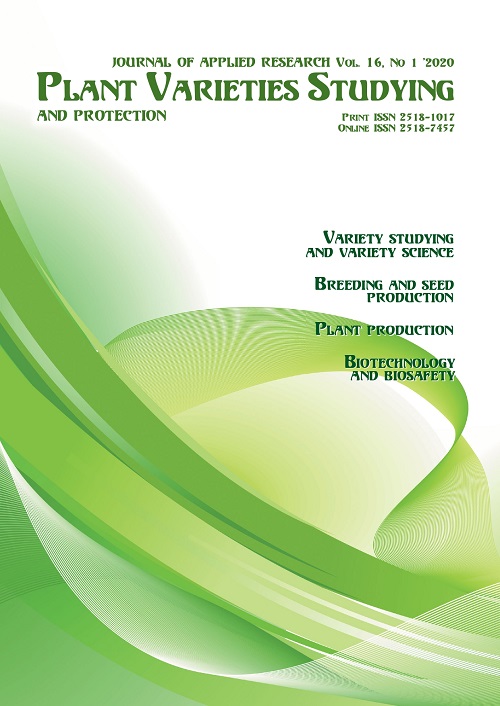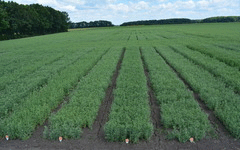The influence of growing factors on the productivity indicators of soybean [Glycine max (L.) Merrill]
DOI:
https://doi.org/10.21498/2518-1017.16.1.2020.201269Keywords:
variety, yield, crude protein content, oil content, protein collection, oil collection, UIPVEAbstract
Purpose. To determine the patterns of influence of growing factors on the economically valuable characteristics of new soybean varieties.
Methods. Field, biochemical methods, analysis of variance.
Results. The rates of the influence of the growing zone, the conditions of the growing season of the year and the soybean variety on the yield, weight of 1000 seeds, the content of crude protein and oil, and protein and oil collection were determined. The greatest influence on the yield of the studied varieties had a growing zone – 55%. On average the maximum yield was obtained in Forest-steppe zone 2.48–3.58 t/ha, the lowest – in Steppe zone (1.33–1.89 t/ha) for 2017–2018. In the same period the weight of 1000 seeds on average was 125.1–169.9 g in the Steppe zone, in Forest-Steppe zone it was 130.2–207.8 g and 143.9–188.0 g in Forrest zone. According to the results of analysis of variance, it was determined that the growing zone has the greatest influence on weight of 1000 seeds – 31%, variety – 21% and conditions of the growing season of the year – 13%. The main characteristics of soybean quality are the content of crude protein and oil in seeds. The highest level of crude protein was observed in soybean variety in Forest-Steppe zone – 37.5–44.0%. In Forrest zone, the crude protein content was 34.4–41.7%, in the Steppe zone 35.4–40.1%. The maximum level of this characteristic was observed in variety ‘NS Diyana’ – 44.0% in Forest-Steppe zone, in Forrest zone – in the variety ‘Alexa’ 41.7%, in Steppe zone – in variety ‘NS Diyana’ 40.1%. Thus, the growing zone (31%) and variety (25%) had the greatest influence on the content of crude protein; the interaction of factors (variety and growing zone) affected 17%. The average oil content for 2017‑2018 ranges from 19.8 to 24.2%. High oil content was noted in ‘Adsoy’ variety in Forrest and Forest-Steppe zones, 24.2 and 22.6%, respectively, and ‘Azimut’ – 23.8% in Steppe zone. The results of the analysis of variance showed that the growing zone to a greater extent affected the oil content in soybean seeds by 25%, variety – 21%, and the interaction of factors of the variety and growing zone by 21%.
Conclusions. According to the results of multifactor analysis of variance, it was determined that the growing zone had the greatest influence on the studied parameters. It was found that the rate of the influence of growing zone of soybean varieties is 25–55%, depending on the studied characteristic. It was determined that the influence of the variety was 4–25%, the conditions of the growing season affected by 1–26%.
Downloads
References
Krenciv, Ya. I. (2019). Variability of elements of efficiency of plants of soya of F1, F2 hybrids. Vìsn. Agrar. Nauki [Вulletin of Agricultural Science], 3, 82–88. doi: 10.31073/agrovisnyk201903-13 [in Ukrainian]
Pidlubna, O. D., & Kontseba, S. M. (2015). The economic efficiency of regional soybeans production. Ekonomìka APK [The Economy of Agro-Industrial Complex], 1, 14–20. [in Ukrainian]
Stupniczka, O. S., & Baranov, A. I. (2014). Influence of elements of cultivation technology on the quality composition of soybean seeds. Vìsnik Žitomirsʹkogo nacìonalʹnogo agroekologìčnogo unìversitetu [Bulletin of Zhytomyr National Agroecological University], 1(1), 237–241. [in Ukrainian]
Kazakova, I. V., & Kondratyuk, N. V. (2015). Efficiency of soybean production and development of soybean products market in Ukraine and worldwide. Efektivna ekonomìka [Efficient Economy], 5. Retrieved from http://www.economy.nayka.com.ua/?op=1&z=4070 [in Ukrainian]
Kaminskyi, V. F., & Mosyondz, N. P. (2010). Influence of the technology elements of soybean cultivation in conditions of the northern Forest-Steppe of Ukraine. Kormi ì kormovirobnictvo [Feeds and Feed Production], 66, 91–95. [in Ukrainian]
Sichkar, V. I. (2013). A more effective use of soybean varietal potential is the need of today. Posibnyk ukrainskoho khliboroba [Ukrainian Cereal Growers Handbook], 2, 145–150. [in Ukrainian]
Slobodyanyk, A. M., & Trishin, O. V. (2018). Practical use of fundamental analysis for forecasting global market prices for soybeans. Efektivna ekonomìka [Efficient Economy], 5. Retrieved from http://www.economy.nayka.com.ua/pdf/5_2018/37.pdf [in Ukrainian]
Ukrainian Institute for Plant Variety Examination. (n.d.). Informatsiino-dovidkova systema «Reiestr sortiv» [Information referral system “Register of varieties”]. Retrieved from http:// service.ukragroexpert.com.ua/index.php [in Ukrainian]
Babych, A. O., & Babych-Poberezhna, A. A. (2012). The world and domestic tendencies of the distribution of soybean production and use to solve the problem of protein. Kormi ì kormovirobnictvo [Feeds and Feed Production], 71, 12–27. [in Ukrainian]
Ivanyuk, S. V. (2012). Formation of variety resources of soybean in accordance with bioclimatic potential of the region of cultivation. Kormi ì kormovirobnictvo [Feeds and Feed Production], 71, 34–41. [in Ukrainian]
Kucharik, C. J., & Serbin, S. P. (2008). Impacts of recent climate change on Wisconsin corn and soybean yield trends. Environ. Res. Lett., 3(3), 034003. doi: 10.1088/1748-9326/3/3/034003
Kravchenko, A. N., & Bullock, D. G. (2000). Correlation of corn and soybean grain yield with topography and soil properties. Agron. J., 92(1), 75–83. doi: 10.1007/s100870050010
Omel’yanyuk, L. V., Asanov, A. M., & Tanakulov, A. Kh. (2012). The influence of hydrothermal support of the growing season on the productivity of early ripening soybean varieties in the Southern Forest-Steppe of the Omsk region. Maslichnye kul’tury. Nauchno-tekhnicheskiy byulleten VNIIMK [Oil Crops. Scientific and technical bulletin of All-Russia Research Institute of Oil Crops], 1, 213–217. [in Russian]
Ozyakova, E. N., & Popolzukhina, N. A. (2014). Yield and quality of soybean depending on the actions of abiotic factors and genotypic characteristics. Omskij naučnyj vestnik [Omsk Scientific Bulletin], 2, 213–217. [in Russian]
Tolmachоva, A. V. (2015). Influence of environmental factors on the dynamics of biomass of soya plants in the central part of the North-Western Black Sea Region. Fìzična geografìâ ta geomorfologìâ [Physical Geography and Geomorphology], 1, 158–166. [in Russian]
Ivaniuk, S. V., Vilhota, M. V., & Zharkova, O. Y. (2016). The impact of hydrothermal conditions on the formation of soybean productivity in the Forest-Steppe of Ukraine. Kormi ì kormovirobnictvo [Feeds and Feed Production], 82, 21–28. [in Ukrainian]
Shevnikov, M. Ya., & Milenko, O. G. (2016). Influence of agroecological factors on protein and oil content in soybean seeds. Vìsnik Centru naukovogo zabezpečennâ APV Harkìvsʹkoï oblastì [Bulletin of the Center for Science Provision of Agribusiness in the Kharkiv region], 20, 84–90. [in Ukrainian]
Egli, D. B., & Bruening, W. (1992). Planting date and soybean yield: evaluation of environmental effects with a crop simulation model: SOYGRO. Agric. For. Meteorol., 62(1–2), 19–29. doi: 10.1016/0168-1923(92)90003-M
Nidzelskyi, V. A., Novytska, N. V., & Shutyi, O. (2012). Directing technological measures to stabilize soybean crops. Naukovij vìsnik NUBIP Ukraïni. Serìâ Agronomìâ [Scientific Herald of NULES of Ukraine. Series: Agronomy], 176, 74–78. [in Ukrainian]
Zarei, I., Sohrabi, Y., Heidari, G. R., Jalilian, A., & Mohammadi, K. (2012). Effects of biofertilizers on grain yield and protein content of two soybean (Glycine max L.) cultivars. Afr. J. Biotechnol., 11(27), 7028–7037. doi: 10.5897/AJB11.3194
Hutianskyi, R. A., Matviiets, V. H., Ilchenko, N. K., & Sheliakina, T. A. (2012). Protein and oil content in soybean seeds grown on the background of herbicide application. Selekciâ i nasìnnictvo [Plant Breeding and Seed Production], 101, 223–229. doi: 10.30835/2413-7510.2012.59761 [in Ukrainian]
Hu, M., & Wiatrak, P. (2012). Effect of planting date on soybean growth, yield, and grain quality. Agron. J., 104(3), 785–790. doi: 10.2134/agronj2011.0382
Bobro, M. A., Ohurtsov, Ye. M., & Mikhyeyev, V. H. (2012). Productivity of soybean varieties of different ripeness groups depending on sowing rates in eastern Ukraine. Vìsnik HNAU. Serìâ Roslinnictvo, selekcìâ ì nasìnnictvo, plodoovočìvnictvo ì zberìgannâ [The Bulletin of Kharkiv National Agrarian University. Crop production, breeding and seed production, horticulture], 2, 30–36. [in Ukrainian]
Prysiazhnyuk, O. I., Hryhorenko, S. V., & Polovynchuk, O. Yu. (2018). Realization of soybean biological potential as affected by agronomical practices under the conditions of the Forest-Steppe of Ukraine. Plant Var. Stud. Prot., 14(2), 215–223. doi: 10.21498/2518-1017.14.2.2018.134773 [in Ukrainian]
Shevnikov, M. Ya., Milenko, O. H., & Lotysh, I. I. (2018). The productivity of soy sorts depending on elements of growing technology. Vìsn. Poltav. derž. agrar. akad. [News of Poltava State Agrarian Academy], 3, 15–21. doi: 10.31210/visnyk2018.03.02 [in Ukrainian]
Paz, J. O., Batchelor, W. D., Tylka, G. L., & Hartzler, R. G. (2001). A modeling approach to quantify the effects of spatial soybean yield limiting factors. Trans. ASAE, 44(5), 1329–1334. doi: 10.13031/2013.6423
Prysiazhniuk, O. I., Dymytrov, V. H., & Martynov, O. M. (2017). Forecasting of phenotypic productivity of middle-early soybean varieties. Plant Var. Stud. Prot., 13(2), 167–171. doi: 10.21498/2518-1017.13.2.2017.105404 [in Ukrainian]
Prysiazhniuk, L. M., Shcherbynina, N. P., Shayuk, L. V., Korol, L. V., Honcharova, S. O., Kostenko, A. V., & Zirnzak, A. V. (2015). Estimation of plasticity and stability of new varieties of soybean in different soil-climatic zones. Naukovì dopovìdì NUBiP Ukraïni [Scientific reports NULES of Ukraine], 8. Retrieved from http://journals.uran.ua/index.php/2223-1609/article/view/115605/109838 [in Ukrainian]
Prysiazhniuk, L. M., Shovgun, O. O., Korol, L. V., Goncharova, S. O., Korovko, I. I., & Kostenko, A. V. (2016). Assessment of new cultivars of soya bean according to economic valuable indexes. Vìsn. Agrar. Nauki [Вulletin of Agricultural Science], 11, 24–27. [in Ukrainian]
Melnyk, S. I., Popova, O. P., & Kociubynska, L. M. (2019). Economic efficiency of production of commodity products of cultural soybean in scientific rotation. Agrosvit [Agro-world], 23, 49–53. doi: 10.32702/2306-6792.2019.23.49 [in Ukrainian]
Tkachyk, S. O. (Ed.). (2011). Metodyka provedennia kvalifikatsiinoi ekspertyzy sortiv roslyn na prydatnist do poshyrennia v Ukraini. Zahalna chastyna [Methods of conducting qualification tests of plant varieties for suitability for distribution in Ukraine. General part]. (3rd ed., rev.). Kyiv: N.p. [in Ukrainian]
Volkodav, V. V. (Ed.). (2001). Metodyka derzhavnoho sortovyprobuvannia silskohospodarskykh kultur. Oliini, tekhnichni, priadyvni ta kormovi kultury [Methods of state variety testing of crops. Oil, technical, fiber and forage crops] (pp. 11). Kyiv: N.p. [in Ukrainian]
Tkachyk, S. O. (Ed.). (2017). Metodyky provedennia kvalifikatsiinoi ekspertyzy sortiv roslyn na prydatnist do poshyrennia v Ukraini. Metody vyznachennia pokaznykiv yakosti produktsii roslynnytstva [Methods of conducting qualitative examination of plant varieties for suitability for distribution in Ukraine. Methods for defining crop quality indicators]. (3rd ed., rev.). Vinnytsia: FOP Korzun D. Yu. [in Ukrainian]
Ermantraut, E. R., Prysiazhniuk, O. I., & Shevchenko, I. L. (2007). Statystychnyi analiz ahronomichnykh doslidnykh danykh v paketi Statistica 6.0 [Statistical analysis of agronomic research data in package Statistica 6.0]. Kyiv: PoligrafKonsaltyng. [in Ukrainian]
Klasyfikator pokaznykiv yakosti botanichnykh taksoniv, sorty yakykh prokhodiat ekspertyzu na prydatnist do poshyrennia [Quality index of botanical taxon quality assorted for suitability for distribution]. (2019). Vinnytsia: TOV «Tvory». Retrieved from https://sops.gov.ua/uploads/page/vidanna/2019/1.pdf [in Ukrainian]
Downloads
Published
How to Cite
Issue
Section
License
Copyright (c) 2020 Ukrainian Institute for Plant Variety Examination

This work is licensed under a Creative Commons Attribution-ShareAlike 4.0 International License.
Starting in 2022, the copyright to the publication remains with the authors
Our journal abides by the CREATIVE COMMONS copyright rights and permissions for open access journals.
Authors, who are published in this journal, agree to the following conditions:
- The authors reserve the right to authorship of the work and pass the first publication right of this work to the journal under the terms of a Creative Commons Attribution License, which allows others to freely distribute the published research with the obligatory reference to the authors of the original work and the first publication of the work in this journal.
- The authors have the right to conclude separate supplement agreements that relate to non-exclusive work distribution in the form in which it has been published by the journal (for example, to upload the work to the online storage of the journal or publish it as part of a monograph), provided that the reference to the first publication of the work in this journal is included.

























 Ukrainian Institute for Plant Varieties Examination
Ukrainian Institute for Plant Varieties Examination  Селекційно-генетичний інститут
Селекційно-генетичний інститут Institute of Plant Physiology and Genetics of the National Academy of Sciences of Ukraine
Institute of Plant Physiology and Genetics of the National Academy of Sciences of Ukraine
 The National Academy of Agrarian Sciences of Ukraine
The National Academy of Agrarian Sciences of Ukraine